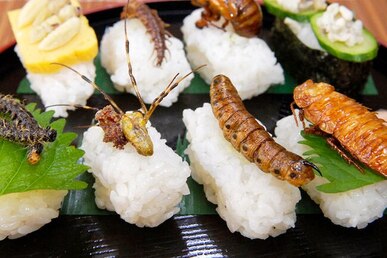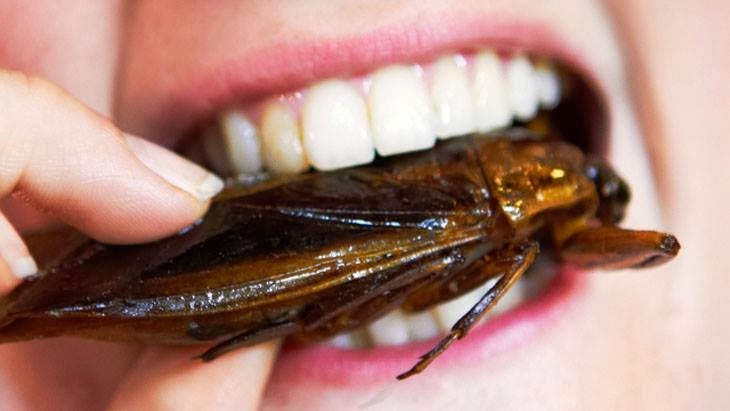|
The tiny ants, buzzing bees, creepy caterpillars and the lush green grasshoppers have etched a place for themselves in history now-beyond being a source of disgust and fear for children and many adults alike, these insects are now considered as a valuable source of nutrition. Yes, you have read it right! Eating insects is not something new to us-man was omnivorous since early development and relied on insects as a source of protein (in the absence of meat from vertebrates) before he could get his hands on tools for hunting and farming. For centuries, individuals in Asia, South America and Europe consumed native insect species and the trend still continues in more than 113 countries worldwide where around 2000 edible insects including ants, bees, wasps, caterpillars, crickets, beetles and grasshoppers are consumed. When the trend has been in practice since ages what exactly garners attention on these insects now? A Ray of Hope in a Malnourished World We are well-aware that malnutrition is killing people and leaving millions susceptible to life-threatening consequences in most developing countries such as Asia and Africa. There are 150 million kids who don’t consume the suggested amount of nutrients or energy for growth and development and almost 52% of them reside in South Asia and 21% of them in Sub-Saharan Africa. This makes edible insects a sheer pleasure to eat for people residing in developing countries-India has identified 24 edible insect varieties and Africa has reported around 246 edible varieties. We don’t have sufficient food today to cover the needs of each individual surviving on this Earth and if projections are accurate, the world population would exceed over 9 billion by 2050 and, we would require almost double times the food production as of that happening currently. Entomophagy (the use of insects as food) which was until now seen with disgust and considered as a primitive form of behavior by people in Western countries has taken a U-turn and we can now see grasshoppers eaten as street food in Mexico, insect rice is widely accepted in USA and bee or wasp larvae/adults are considered to be an expensive delicacy in Japan (in sushi and more). When we look at the reason behind such a drastic change in the last couple of decades, we can clearly define that rise in nutrient needs, especially the demand for protein sources exists as the primary reason behind its acceptance and usage. Most edible insects are great sources of energy, protein, amino acids, mono- and polyunsaturated fatty acids, vitamins like riboflavin, pantothenic acid, biotin and folic acid and trace elements such as copper, iron, magnesium, manganese, phosphorus, zinc and selenium. The nutritional value also depends on the variability of the species, the stage of metamorphosis of the insect, its diet and origin and also changes depending on the preparation and processing method of the same. For instance, larvae/pupae contain higher energy compared to adults and high-protein insects contain lower energy content. Protein content of insects are only a tad lesser than the protein content in animals and almost higher than most plant proteins. Fat content are highest in the larval stage of insects with caterpillars containing greater amount of fats. Fiber is yet another nutrients that’s present in significant quantities in these insects with chitin being the most common form of fiber in the insect body. Chitin presence is greatly valued as it helps to improve immunity of certain groups of people and reduce allergic reaction in some other individuals. Though people in developing countries consume insects mainly for sustenance of life these creatures offer more than this! A study in Thailand proved that eating 100 grams of insects had equal or even more calories than that of equal weight of commonly consumed livestock except pork. Some varieties of insects found in China offer more proteins than those in most plants, meats and eggs. People in developing countries not only suffer from protein deficiency but also lack most of the macronutrients and micronutrients. A study by Womeni and others on six insect species from sub-Saharan Africa analysed for their lipid and fatty acid content showed that these were not only rich in fat but also a good source of polyunsaturated fatty acids. Iron deficiency is the world’s most common nutritional disorder and the good news is that many of the edible insects are excellent iron sources whose ranges exceed that of common animal sources. Insects are also good sources of zinc. Still, protein malnutrition exists as the topmost cause of health problems in developing countries owing to higher costs associated with animal foods. Every 1 in 5 kids under the age of 5 are victims of protein deficiency while the demand for meat is only steadily increasing. It is only ideal that we come up with alternate protein sources to meet the rising demands and studying the relevancy of insects as authentic protein sources makes complete sense. Protein Quality of Insects Available in Nigeria Nigeria has a diverse collection of insects and a group of researchers interested in analysing insects as a source of protein determined the protein quality of some of the commonly consumed insects in Nigeria and the effect of dietary supplementation of these insects on albino rats. Termites, cricket, grasshopper and moth caterpillars were some of the insects that were primarily focused in the study. All the insects were washed, their wings removed, sun dried, powdered and stored in plastic containers. Amino acid profile was analysed using a Technicon sequential Multi-sample Amino Acid Analyser (TSM) and the score was calculated based on the amino acid requirements for preschool children aged between 2 and 5 years. Protein quality of each insect was calculated using growth methods (such as protein efficiency ratio (PER) and net protein ratio and biological value (BV)), nitrogen balance methods and protein digestibility corrected for amino acid score (PDCAAS) method. The researchers formulated six diets each of which contained 10% of test proteins and used 36 young male weanling albino rats almost 21-28 days old. The animals were divided into six groups of 6 rats in each with each group fed as below: Group 1: N-free basal diet Group 2: Casein diet Group 3-6: Fed with diets containing insect sample as the sole source of protein All the rats were fed the respective diets for 28 days and a 24h feeding trial was conducted with the daily intake calculated using feed remnants and subtracting it from total amount of feed given to them in the first place. The rats were measured of their body weight at the start of the study and then on a weekly basis until the end of study. PER, PDCAAS and net protein ratio (NPR) values were calculated using formulas.  Insects Rather than Fish are Used as the Primary Source of Protein in Some Sushi Insects Rather than Fish are Used as the Primary Source of Protein in Some Sushi Results The insects considered for study contained all 20 naturally occurring amino acids proving that they are rich sources of both essential (grasshopper contained the most abundant amino acid, threonine and caterpillar contained the least abundant with methionine) and non-essential (glutamic acid was most abundant and cystine was least abundant) amino acids. At week 1 rats fed with termite diet had least intake and crickets contributed to highest intake. The other rats fed with basal, grasshopper, termite and moth caterpillar diets did not show any significant difference. During third week, intake of rats fed with casein decreased and those fed with moth caterpillar increased with other insect intakes showing no significant difference. At week 4, rats fed with cricket had highest intake and those fed with basal diet lost a great weight after the first week until the end of experiment while those fed with casein diet had a slight loss of weight after week 1 but improved during the upcoming weeks. Rats fed with moth caterpillar and grasshopper lost weight during week 1 and 2 but gained weight by week 4. On the whole, those rats fed with cricket displayed significantly higher weight gain than those placed on supplemented diets. Protein: Cricket had the highest PER and NPR values and termites had lowest PER and NPR values. Casein displayed higher value for true digestibility compared to other insect proteins while termites displayed higher digestibility compared to cricket, moth and grasshopper proteins. Casein displayed least biological value and cricket had the highest biological value. Rats fed with casein supplementation had highest serum concentration of albumin and those fed with basal diet had lowest concentration of serum albumin while those fed with cricket and moth caterpillar diets showed no change in serum concentrations. Total protein concentration of rats feeding on caterpillar and cricket was comparable to that of rats fed with casein while total protein concentration of those rats fed with basal, grasshopper and termite diets were lower than those placed on casein supplement diets. Total protein concentration of rats fed on casein diets was similar to the result of those placed on moth caterpillar and cricket diets but higher than those placed on other diets. The study clearly showed that cricket had the highest protein quality compared to termite, grasshopper and moth caterpillars (these contained lowest quantity due to the deficiency of sulphur containing amino acids and isoleucine). At the same time, these insects are good sources of essential amino acids such as lysine and can be used as complementary staple food. It does seem that consuming insects seems appealing in terms of protein content and nutrients. All that needs to be done now is to overcome the disgust and ‘yucky’ feeling to accommodate the needs of the growing population demands. References Protein Quality of Four Indigenous Edible Insect Species in Nigeria: https://www.sciencedirect.com/science/article/pii/S2213453017301015 Insect Protein: A Sustainable and Healthy Alternative to Animal Protein? https://academic.oup.com/jn/article/149/4/545/5428116 Edible Insects as a Protein Source: A Review of Public Perception, Processing Technology & research Trends: https://www.ncbi.nlm.nih.gov/pmc/articles/PMC6728817/ Edible Insects as a Means to Address Global Malnutrition & Food Insecurity Issues: https://academic.oup.com/fqs/article/2/1/17/4911878 Nutritional & Sensory Quality of Edible Insects: https://www.sciencedirect.com/science/article/pii/S2352364616300013
0 Comments
Leave a Reply. |
AVOID FRAUD. EAT SMART.+91 7846 800 800
AuthorDietitian & Nutritionist Dr. Nafeesa Imteyaz. Archives
July 2024
Categories
All
Dr. Nafeesa's Blog @blogspot |
- Home
- Written Testimonials
- Consult
- Clinics
- Blogs
-
Diet & Nutrition
- Diabetes Reversal
- IVF IUI not needed for PCOS PCOD Infertility
-
Medical Nutrition
>
-
Disease & Conditions
>
- Infertility | PCOS
- Diabetes Mellitus
- Cholesterol
- Hypothyroid
- Kidney Problems
- Hypertension
- Cardiovascular Diseases
- Liver Diseases
- Gastro intestinal disorder
- Cancer
- Metabolic Disorders
- Orthopedic Disorders
- Eating Disorders
- Dietary Recall
- Weight Record Filled By Clients
- Online Payment Transaction Details
- Online Clients Weight Check Form
- Our Program Package Service Charges
- Weight Record 2017 Clients
- Measurements sent by Clients
- Terms & Conditions Of Payment
- Thanks. Your Form is Submitted
- Video Testimonials
- Lifestyle & Wellness
- Lifestyle & Wellness Blog
- Allergy & Intolerance
- Weight Loss / Gain
- Weight Loss / Slimming Blog
-
Disease & Conditions
>
- Life Cycle Nutrition >
- Sports Nutrition >
- Integrity in Nutrition
- Knowledge Centre
© COPYRIGHT 2022. ALL RIGHTS RESERVED. FRST HEALTHCARE PVT LTD.
Dr. Nafeesa Imteyaz of First Eat Right clinic, is the Best Dietitian Nutritionist in Bangalore. Best Dietitian Nutritionist in Pune. Best Dietitian Nutritionist in Hyderabad. Best Dietitian Nutritionist in Chennai. Best Dietitian Nutritionist in Mumbai. Best Dietitian Nutritionist in Delhi. Best Dietitian Nutritionist in Kolkata.


